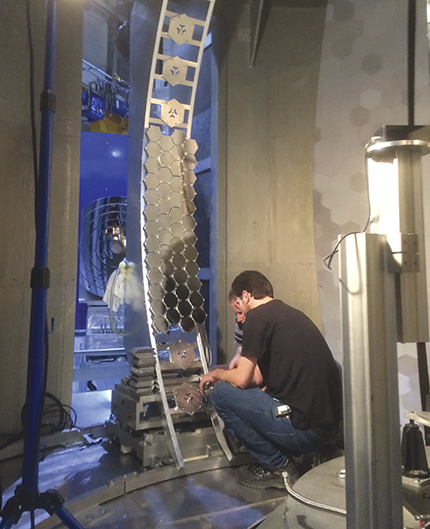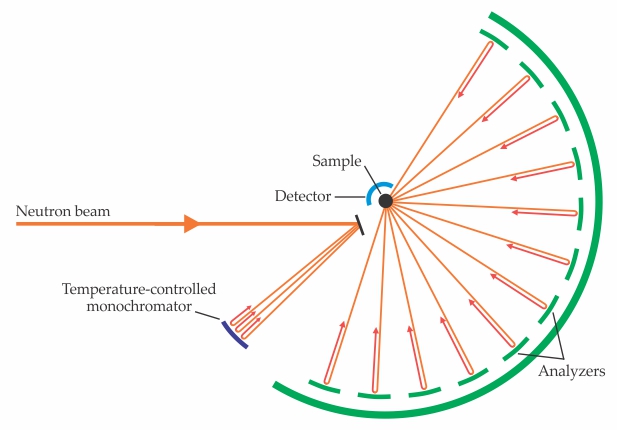Boosting the resolution of neutron backscattering spectroscopy
DOI: 10.1063/PT.3.4157
Experiments with subatomic particles don’t often have to account for gravitational potential energy. A proton or neutron moving through Earth’s gravitational field gains or loses just 100 neV for every meter of altitude change. For many purposes, that’s an insignificant amount.
But a new proof-of-concept neutron backscattering spectrometer is so sensitive to tiny changes in energy that gravitational effects matter.
1
The spectrometer (whose vertical scale is shown in figure
Figure 1.

Kristijan Kuhlmann (front) and Markus Appel (back, almost hidden) examine part of a gallium arsenide analyzer in a proof-of-concept neutron backscattering spectrometer. In a fully functional spectrometer, the hexagonal GaAs facets will cover about 20% of the surface area of a sphere centered on the sample (right foreground).
BERNHARD FRICK

Neutron backscattering spectroscopy is used to measure the minute energy shifts in neutrons that scatter off a sample. Those energy changes can result from sample resonances, such as phonons or hyperfine excitations. They can also arise from random motions such as diffusion: Neutrons scattering off moving molecules acquire positive or negative Doppler shifts, and the resulting broadening of their energy spread provides information about the mobility of molecules in the sample.
The technique has been used to study, among other things, the diffusion of protons in fuel cells and the movement of water in biological and geological specimens. Improved energy resolution opens the door to studying dynamics that are slower or more complicated—such as different components of the sample diffusing at different rates—and wider ranges of temperature, pressure, and other parameters.
Bragg backscattering
The ILL is one of several user facilities worldwide that are dedicated to neutron research. Neutrons are produced in a central nuclear reactor and distributed among several dozen instruments, on which users can book time for their experiments.
The beamline neutrons have too broad a kinetic energy spread for the slight shifts imparted by the sample to be discernable. Neutron backscattering spectroscopy uses Bragg reflection to pick out neutrons of a particular energy. As shown in the schematic in figure
Figure 2.

The neutron backscattering spectroscopy setup, shown schematically. Incoming neutrons first reflect off the temperature-controlled monochromator, then scatter off the sample, then reflect off the analyzers. Neutrons reach the detector only if their energies satisfy the Bragg condition at both the monochromator and the analyzer—that is, if the energy gained or lost by scattering in the sample matches the temperature shift imparted by the monochromator.

After scattering off the sample, which may or may not involve a slight change in energy, the neutrons collide with a large spherical shell of crystalline analyzers. If and only if the Bragg condition is satisfied again are the neutrons reflected back toward the detector. If the monochromator and analyzers are made of identical crystalline materials, then, the detected neutrons are the ones that neither gain nor lose energy in the sample. By adjusting the monochromator’s temperature, one can select for neutrons that gain or lose a specific amount of energy: Warmer crystals have slightly larger lattice spacing, so they reflect slightly longer-wavelength neutrons.
The material chosen for the monochromator and analyzers needs to be one that can readily be fabricated into large-area, high-quality crystalline wafers. Ever since the first prototype 2 in 1969, neutron backscattering spectrometers have used the (111) surface of silicon. And from the beginning, spectrometers were almost perfectly optimized for that material: The 1969 prototype had an energy resolution of 620 neV, and the best Si(111) spectrometer today has a resolution of 300 neV.
That resolution is largely limited by the intrinsic linewidth of the Si(111) reflection. The Si atoms scatter neutrons strongly: Neutrons with resonant energy penetrate just 34 µm into the crystal, so only 105 atomic layers participate in the reflection, and the destructive interference at off-peak energies is incomplete. It’s been known since the 1990s that the reflection off the (200) surface of gallium arsenide could potentially do better. 3 Because that material scatters neutrons less strongly, the beam penetrates 10 times as far into the crystal. As a result, the peak reflection intensity is the same as for Si(111), but the stronger extinction at off-peak energies makes the reflected energy range much narrower.
Realizing resolution
In the 1990s GaAs fabrication wasn’t yet sufficiently advanced for a large-area perfectly crystalline analyzer to be feasible. Now it is. But building the analyzer is a lot more involved than piecing together some commercially available GaAs crystalline wafers. Several other resolution-limiting effects—including facet alignment, beam geometry, and crystal strain—had to be controlled more precisely than in a conventional Si(111) spectrometer. “If any one of them was neglected,” says postdoc Markus Appel, who worked on the project, “progress would be stalled. We often had to take a step back and shift our attention to identifying and working on the current weakest link in the chain.”
One of those potential weak links is the effect of gravity. All else being equal, neutrons scattered from the sample toward the top of the analyzer end up with 300 neV less energy than those scattered toward the bottom. Leaving that effect uncorrected would obliterate all other resolution-improving advances. To compensate for gravity’s influence, the researchers introduce a thermal gradient such that the bottom of the analyzer is 10 K cooler than the top.
To test the energy resolution, the researchers made some proof-of-concept measurements, including the hyperfine spectrum of cobalt. But the new spectrometer isn’t ready for users yet. The analyzers constructed so far represent just 3% of the area of a fully furbished instrument. And there’s still some room for improvement in resolution: The theoretical limit for an ideal GaAs(200) crystal is just 13 neV.
References
1. K. Kuhlmann et al., Rev. Sci. Instrum. 90, 015119 (2019). https://doi.org/10.1063/1.5046476
2. B. Alefeld, M. Birr, A. Heidemann, Naturwissenschaften 56, 410 (1969). https://doi.org/10.1007/BF00593617
3. B. Alefeld, T. Springer, Nucl. Instrum. Methods Phys. Res. A 295, 268 (1990); https://doi.org/10.1016/0168-9002(90)90446-D
K.-D. Liss, A. Magerl, W. Gläser, Nucl. Instrum. Methods Phys. Res. A 335, 523 (1993). https://doi.org/10.1016/0168-9002(93)91239-J
